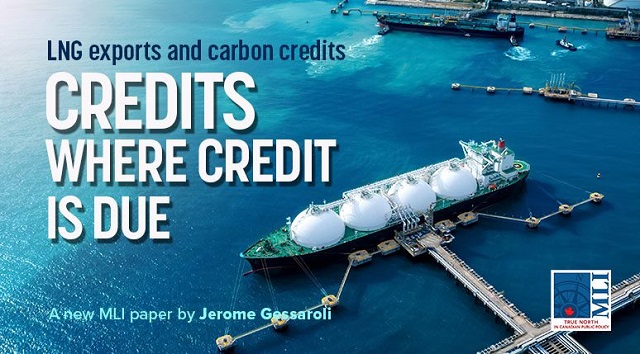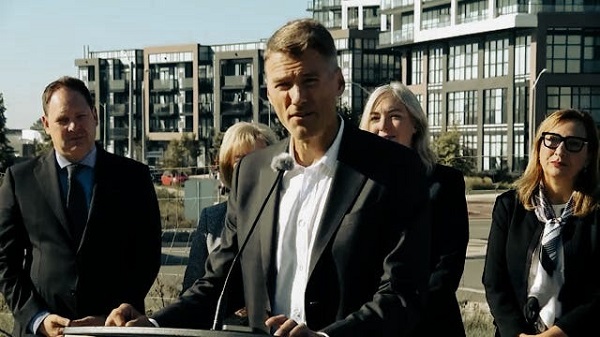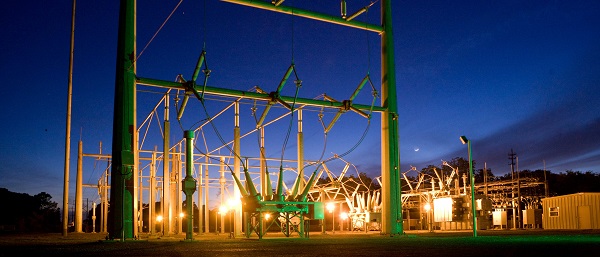Economy
Credits where credit is due: LNG exports and carbon credits

From the MacDonald Laurier Institute
By Jerome Gessaroli
Canada should announce its intent to use Article 6 as a tool to help meet its emissions reduction targets
In this new paper, LNG exports and carbon credits: Credits where credit is due, MLI Senior Fellow Jerome Gessaroli makes the case that Canada can earn ITMOs ( Internationally Transferable Mitigation Outcomes) based on exports of British Columbia-sourced Liquified Natural Gas (LNG). With the potential to significantly lower global carbon emissions and displace coal power in the Asia-Pacific region, such a strategic move by Canada to harness BC’s LNG offers a transformative solution.
Executive Summary
Under the basic current climate accounting rules to which Canada and all other UNFCCC parties have agreed, countries are responsible for reducing GHG emissions within their own national borders. If a country supported a project in another country, it would receive zero credit, no matter what help it may have provided. Therefore, countries have a big incentive to fund projects only within their own borders to help meet their own national carbon reduction goals. That is unfortunate for the planet’s emission reduction efforts. The focus on emission targets within national borders is a shortfall in the nationally based climate accounting system.
To address this shortcoming, the UNFCCC has adopted a framework covered in Article 6 of the Paris Agreement enabling countries to cooperate and share emission reductions. This framework allows carbon credits (known as internationally transferable mitigation outcomes, or ITMOs) to be transferred from the country where the reductions occurred to the country that helped undertake the emissions reduction project.
Sharing emissions reductions through Article 6 is possible when liquefied natural gas (LNG) replaces coal in power generation. This substitution is especially important because coal-fired power plants are expected to produce large amounts of the world’s energy (and GHGs) over the next several decades, even though coal emits much more carbon than other primary fuel sources. Even more troublesome is that new coal plants are still being built in significant numbers. Those new plants alone are expected to emit over 1,415 Mt CO2e (mega tonnes of CO2 equivalent) per year, which dwarfs Canada’s national targeted reductions of approximately 310 Mt CO2e per year by 2030.
Canada, meanwhile, is preparing to become a supplier of LNG. New LNG projects within British Columbia are amongst the least carbon-intensive sources of LNG in the world. BC’s LNG exports could lower global carbon emissions by displacing coal power, particularly in the Asia-Pacific region. Developing markets in Asia would welcome rapidly rising LNG imports. Realistically, BC LNG should be fully used as a substitute fuel to mitigate the carbon emissions impact of existing coal-based power plants, especially those currently used for heating.
While the concept of Article 6, where carbon credits are shared for collaboratively developed projects, is straightforward, the criteria and rules for implementing it are complex. This paper makes the case for how Canada can earn ITMOs based on exports of British Columbia-sourced LNG. An important criterion for making projects ITMO eligible is that the project would not have gone ahead without carbon credits being available. This suggests deals should be structured involving LNG exports along with some other value-added Canadian participation that assists a developing country in switching from coal to LNG as a fuel source. The ITMOs Canada receives could offset any incremental costs we would incur.
If Article 6 is used, the assertion that British Columbia’s pursuit of LNG production would prevent the province from meeting its emission reduction becomes inaccurate. Just over half of LNG Canada’s Phase 1 production capacity in British Columbia would result in approximately 1.2 Mt CO2e emissions annually. Using the same production capacity to replace coal for power generation in Asia has the potential to significantly reduce emissions, ranging from 14.9 to 35.2 Mt CO2e per year. Such outcomes underscore the importance of international collaborative efforts.
Canada should announce its intent to use Article 6 as a tool to help meet its emissions reduction targets. The federal government should then work with industry to identify candidates for bilateral agreements. Common methodologies for measuring, tracking, and verifying carbon mitigation outcomes would all need to be developed as would a registry for tracking and transferring ITMOs. These are complex issues, but we can learn from other countries that have already established processes for managing such projects.
Jerome Gessaroli is a senior fellow with the Macdonald-Laurier Institute and is the project lead for the British Columbia Institute of Technology’s Sound Economic Policy Project. He writes on economic and environmental matters, from a market-based principles perspective.
Business
“Nation Building,” Liberal Style: We’re Fixing a Sewer, You’re Welcome, Canada

Ottawa held a full-blown press conference to announce they unclogged a pipe in Toronto and called it a generational housing strategy.
You probably didn’t hear much about it unless you were watching Canadian state media but this morning, the Liberal government held a press conference in Toronto. It was billed as a “generational investment” in housing. That’s the phrase they used. In reality, it was a sewer project.
Gregor Robertson, the former mayor of Vancouver and now the federal minister of housing and infrastructure, stood beside Toronto Mayor Olivia Chow and a cluster of Liberal MPs to announce that Ottawa is spending $283 million to upgrade the Black Creek trunk sewer line. That’s a pipe. A very old pipe. And according to Robertson, that investment will “unlock” the construction of up to 63,000 new homes in the Downsview area.
If that sounds suspiciously like taking credit for doing your job, maintaining the basic infrastructure cities rely on, that’s because it is. No one has ever accused the Liberals of missing an opportunity to repackage civic maintenance as a national moral crusade. The sewer line is 65 years old. It overflows during storms. It’s been a known problem for decades. Fixing it is not bold housing policy. It’s plumbing.
But the political optics are irresistible. The Trudeau Liberals, now under the leadership of Mark Carney are desperate for a win on housing. Their record is catastrophic. Home prices have doubled. Rents have soared. Entire generations of Canadians have been priced out of ownership and locked into permanent renter status. And the architects of that disaster are now flying around the country handing out ribbon-cutting ceremonies and calling it reform.
Today’s announcement also included the unveiling of the first project under a brand-new federal housing agency, Build Canada Homes. Never heard of it? That’s because it didn’t exist until a few weeks ago. And who’s running it? None other than Ana Bailão a Liberal operative and former Toronto city councillor who spent years helping make the city unaffordable in the first place. Now she’s being rewarded with a cushy federal appointment, tasked with building modular housing and handing out contracts on public land.
And what exactly is Build Canada Homes building? Today, they’re launching 540 homes. Not 63,000… 540. Factory-built units that will be delivered at some undefined point in the future. That’s the big federal breakthrough. A housing crisis affecting millions of Canadians, and Ottawa’s answer is five hundred and forty modular homes in Downsview.
This is the pattern every time. The government breaks something, calls it a crisis, and then demands credit for fixing a fraction of it with your money. The numbers are staggering. According to the Parliamentary Budget Office, Canada needs 3.1 million more homes by 2030 to restore affordability. That means building over 430,000 units per year. Right now, we’re building maybe half that. The backlog gets worse every year. But today, we’re supposed to celebrate because they’re unclogging a sewer and firing up a couple prefab builds on federal land.
No one in the press asked the obvious question: why aren’t private builders constructing the 300,000 units that Toronto has already zoned and approved? Because they can’t. The financing doesn’t work. The cost of materials is too high. Interest rates have crippled developers. And cities like Toronto still impose hundreds of millions of dollars in fees, development charges, and bureaucratic red tape. That’s the real bottleneck. Not the sewer. And here’s what they definitely won’t say out loud: Canada’s housing disaster is not just about supply. It’s about demand, turbocharged by one of the fastest immigration intakes in the Western world. The Bank of Canada has warned repeatedly that immigration targets, set without any link to housing capacity — have blown demand wide open and put relentless upward pressure on rents and home prices.
Mayor Chow admitted it herself, sort of. She said the city has thousands of units ready to build but no takers. And instead of confronting the root causes, monetary policy, taxes, regulatory insanity, the government announces a pilot project and tells you to be grateful. That’s how disconnected they are from reality. They’ve regulated housing out of reach and now they’re posing for photos on a construction site, pretending to be the solution.
And just in case there was any lingering doubt about how deep this failure runs, Statistics Canada released its latest building permit numbers this morning and the trend is exactly what you’d expect in a country where the government makes building homes all but impossible.
The total value of building permits dropped again in August down $139 million to $11.6 billion. Residential permits alone fell 2.4%, driven by steep declines in Ontario and Alberta, the very provinces with the most acute housing needs. Single-family permits fell off a cliff — down more than 10% year-over-year. That’s not a slowdown. That’s a stall.
Meanwhile, British Columbia and Quebec where government intervention is particularly heavy barely managed to offset the damage. The number of new dwellings authorized actually shrank month over month. And this is happening in the middle of a so-called national housing push.
StatsCan didn’t sugarcoat it. They didn’t blame foreign investors or greedy landlords or some phantom market force. They just showed the raw data: Permits are falling. Housing starts are lagging. Builders are retreating.
So let’s just pause here and appreciate the sheer absurdity of what we witnessed. A parade of officials, flanked by branded podiums and tax-funded media handlers, standing in front of a construction site to announce, with straight faces, that they are upgrading a sewer line. And for this, we are told we are “building Canada strong.” Really? That’s the pitch? Fixing basic municipal plumbing is now a nation-building moment?
No! Let’s be clear, you’re not building Canada strong. You’re doing your job. A sewer upgrade in Toronto is not some heroic act of visionary leadership. It’s literally maintenance. It’s what functioning governments are supposed to do, quietly, competently, without a six-camera press choreography and a round of applause from party MPs.
But in Liberal Carney Canada the bar has been lowered so dramatically that simply clearing a permit backlog and patching old infrastructure is treated like a moon landing. They break the system, congratulate themselves for patching one pipe, and expect gratitude.
If you want praise for fixing aging civic infrastructure, something cities used to handle without a national press event, then that tells us everything. It tells us the Liberal government has become so hollow, so addicted to performance politics, that maintenance is now treated as achievement. That’s how far we’ve fallen in just ten years.
They didn’t rebuild a nation. They didn’t launch a housing renaissance. They unclogged a sewer, and are now demanded a standing ovation. And that, in a single image, is modern Liberal Canada: the total collapse of standards, repackaged as progress and sold back to you at full price.
Canadians don’t need more press conferences. They need homes, dignity, and a government that works without constant applause. And if unclogging a pipe is what passes for leadership now — then God help the country.
Subscribe to The Opposition with Dan Knight .
For the full experience, upgrade your subscription.
Business
Your $350 Grocery Question: Gouging or Economics?

Dr. Sylvain Charlebois, a visiting scholar at McGill University and perhaps better known as the Food Professor, has lamented a strange and growing trend among Canadians. It seems that large numbers of especially younger people would prefer a world where grocery chains and food producers operated as non-profits and, ideally, were owned by governments.
Sure, some of them have probably heard stories about the empty shelves and rationing in Soviet-era food stores. But that’s just because “real” communism has never been tried.
In a slightly different context, University of Toronto Professor Joseph Heath recently responded to an adjacent (and popular) belief that there’s no reason we can’t grow all our food in publicly-owned farms right on our city streets and parks:
“Unfortunately, they do have answers, and anyone who stops to think for a minute will know what they are. It’s not difficult to calculate the amount of agricultural land that is required to support the population of a large urban area (such as Tokyo, where Saitō lives). All of the farms in Japan combined produce only enough food to sustain 38% of the Japanese population. This is all so obvious that it feels stupid even to be pointing it out.”
Sure, food prices have been rising. Here’s a screenshot from Statistics Canada’s Consumer Price Index price trends page. As you can see, the 12-month percentage change of the food component of the CPI is currently at 3.4 percent. That’s kind of inseparable from inflation.

But it’s just possible that there’s more going on here than greedy corporate price gouging.
It should be obvious that grocery retailers are subject to volatile supply chain costs. According to Statistics Canada, as of June 2025, for example, the price of “livestock and animal products” had increased by 130 percent over their 2007 prices. And “crops” saw a 67 percent increase over that same period. Grocers also have to lay out for higher packaging material costs that include an extra 35 percent (since 2021) for “foam products for packaging” and 78 percent more for “paperboard containers”.
In the years since 2012, farmers themselves had to deal with 49 percent growth in “commercial seed and plant” prices, 46 percent increases in the cost of production insurance, and a near-tripling of the cost of live cattle.
So should we conclude that Big Grocery is basically an industry whose profits are held to a barely sustainable minimum by macro economic events far beyond their control? Well that’s pretty much what the Retail Council of Canada (RCC) claims. Back in 2023, Competition Bureau Canada published a lengthy response from the RCC to the consultation on the Market study of retail grocery.
The piece made a compelling argument that food sales deliver razor-thin profit margins which are balanced by the sale of more lucrative non-food products like cosmetics.
However, things may not be quite as simple as the RCC presents them. For instance:
- While it’s true that the large number of supermarket chains in Canada suggests there’s little concentration in the sector, the fact is that most independents buy their stock as wholesale from the largest companies.
- The report pointed to Costco and Walmart as proof that new competitors can easily enter the market, but those decades-old well-financed expansions prove little about the way the modern market works. And online grocery shopping in Canada is still far from established.
- Consolidated reporting methods would make it hard to substantiate some of the report’s claims of ultra-thin profit margins on food.
- The fact that grocers are passing on costs selectively through promotional strategies, private-label pricing, and shrinkflation adjustments suggests that they retain at least some control over their supplier costs.
- The claim that Canada’s food price inflation is more or less the same as in other peer countries was true in 2022. But we’ve since seen higher inflation here than, for instance, in the U.S.
Nevertheless, there’s vanishingly little evidence to support claims of outright price gouging. Rising supply chain costs are real and even high-end estimates of Loblaw, Metro, and Sobeys net profit margins are in the two to five percent range. That’s hardly robber baron territory.
What probably is happening is some opportunistic margin-taking through various selective pricing strategies. And at least some price collusion has been confirmed.
How much might such measures have cost the average Canadian family? A reasonable estimate places the figure at between $150 and $350 a year. That’s real money, but it’s hardly enough to justify gutting the entire free market in favor of some suicidal system of central planning and control.
-

 Censorship Industrial Complex21 hours ago
Censorship Industrial Complex21 hours agoCanada’s privacy commissioner says he was not consulted on bill to ban dissidents from internet
-

 Business1 day ago
Business1 day agoFinance Committee Recommendation To Revoke Charitable Status For Religion Short Sighted And Destructive
-

 Alberta1 day ago
Alberta1 day agoOil Sands are the Costco of world energy – dependable and you know exactly where to find it
-

 Alberta20 hours ago
Alberta20 hours agoEnbridge CEO says ‘there’s a good reason’ for Alberta to champion new oil pipeline
-

 Business20 hours ago
Business20 hours agoFormer Trump Advisor Says US Must Stop UN ‘Net Zero’ Climate Tax On American Ships
-

 Energy1 day ago
Energy1 day agoIndigenous Communities Support Pipelines, Why No One Talks About That
-

 Health1 day ago
Health1 day agoColorado gave over 500 people assisted suicide drugs solely for eating disorders in 2024
-

 Business2 days ago
Business2 days agoFinance Titans May Have Found Trojan Horse For ‘Climate Mandates’











